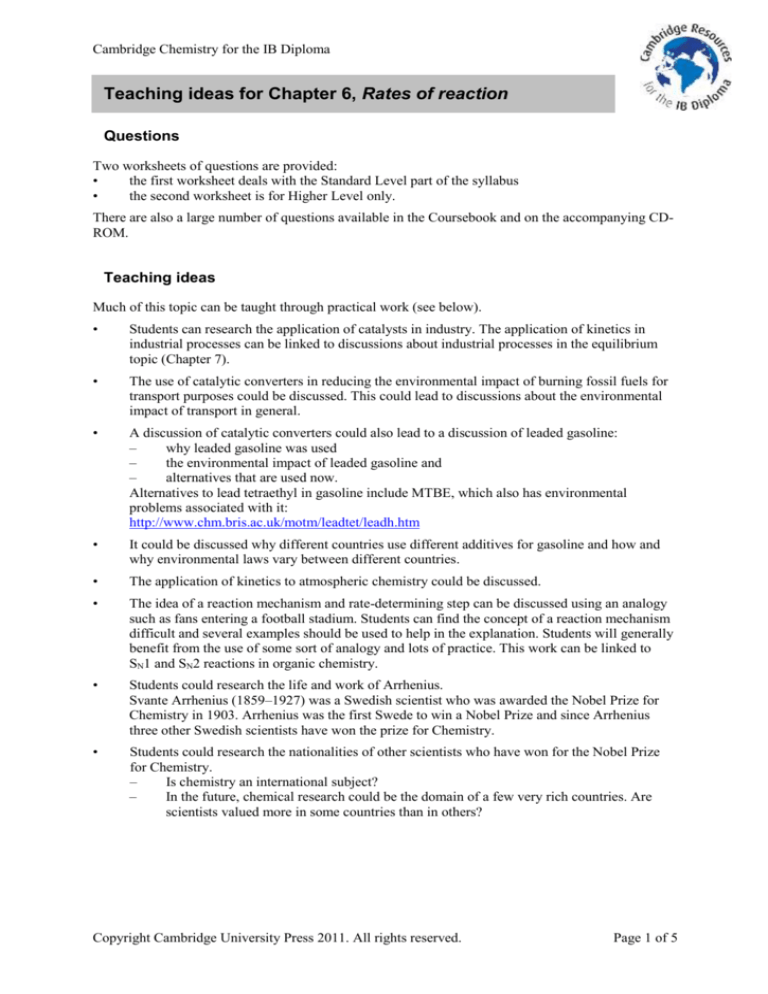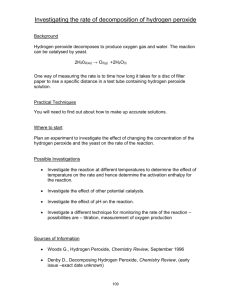
Cambridge Chemistry for the IB Diploma
Teaching ideas for Chapter 6, Rates of reaction
Questions
Two worksheets of questions are provided:
•
the first worksheet deals with the Standard Level part of the syllabus
•
the second worksheet is for Higher Level only.
There are also a large number of questions available in the Coursebook and on the accompanying CDROM.
Teaching ideas
Much of this topic can be taught through practical work (see below).
•
Students can research the application of catalysts in industry. The application of kinetics in
industrial processes can be linked to discussions about industrial processes in the equilibrium
topic (Chapter 7).
•
The use of catalytic converters in reducing the environmental impact of burning fossil fuels for
transport purposes could be discussed. This could lead to discussions about the environmental
impact of transport in general.
•
A discussion of catalytic converters could also lead to a discussion of leaded gasoline:
–
why leaded gasoline was used
–
the environmental impact of leaded gasoline and
–
alternatives that are used now.
Alternatives to lead tetraethyl in gasoline include MTBE, which also has environmental
problems associated with it:
http://www.chm.bris.ac.uk/motm/leadtet/leadh.htm
•
It could be discussed why different countries use different additives for gasoline and how and
why environmental laws vary between different countries.
•
The application of kinetics to atmospheric chemistry could be discussed.
•
The idea of a reaction mechanism and rate-determining step can be discussed using an analogy
such as fans entering a football stadium. Students can find the concept of a reaction mechanism
difficult and several examples should be used to help in the explanation. Students will generally
benefit from the use of some sort of analogy and lots of practice. This work can be linked to
SN1 and SN2 reactions in organic chemistry.
•
Students could research the life and work of Arrhenius.
Svante Arrhenius (1859–1927) was a Swedish scientist who was awarded the Nobel Prize for
Chemistry in 1903. Arrhenius was the first Swede to win a Nobel Prize and since Arrhenius
three other Swedish scientists have won the prize for Chemistry.
•
Students could research the nationalities of other scientists who have won for the Nobel Prize
for Chemistry.
–
Is chemistry an international subject?
–
In the future, chemical research could be the domain of a few very rich countries. Are
scientists valued more in some countries than in others?
Copyright Cambridge University Press 2011. All rights reserved.
Page 1 of 5
Cambridge Chemistry for the IB Diploma
Practical activities
Safety
Extreme care must be exercised when carrying out any practical activities in the classroom and a risk
assessment should be conducted before carrying out the experiments.
Demonstrations
•
There are various demonstrations that can be carried out to demonstrate the idea of rate of
reaction:
–
a very slow reaction would be the rusting of iron
–
moderate speed reactions would be the reaction of magnesium metal or calcium
carbonate with hydrochloric acid (add magnesium ribbon or marble chips to 1 mol dm–3
hydrochloric acid in a beaker)
–
a fast reaction could be a methane/oxygen or hydrogen/oxygen explosion:
http://www.rsc.org/Education/EiC/issues/2010November/ExhibitionChemistry.asp
•
The method of determining the rate of reaction by measuring the decrease in mass of a system
in which a gas is produced can be illustrated by conducting the reaction between calcium
carbonate and hydrochloric acid on an electronic balance. The experimental set-up is given in
the Coursebook, page 243.
•
The idea that two particles must collide with sufficient energy in order for a reaction to occur
can be demonstrated by rolling two apples together gently (no reaction) or pushing them
together very hard so that they break.
•
The effect of surface area on the rate of a reaction can be illustrated by sprinkling dry custard
powder/milk powder/lycopodium powder into a flame or using a syringe to push these through
a flame:
http://www.practicalchemistry.org/experiments/the-cornflour-bomb,224,EX.html
http://www1.chem.leeds.ac.uk/delights/texts/expt_6.html
http://dwb4.unl.edu/Chemistry/dochem/DoChem048.html
http://www.angelo.edu/faculty/kboudrea/demos/lycopodium/lycopodium.htm
Combustible dust explosions have killed many people over the years. Dusts have a very high
surface area. An explosion can occur when flour dust, grain dust or coal dust is present in the
air and is ignited. A great deal of care must therefore be exercised in industries which generate
combustible dusts and regulations are in place to reduce the chance of dust explosions.
Various reactions can be carried out to illustrate catalysis.
•
The decomposition of hydrogen peroxide (100 volume is spectacular) using MnO2 as the
catalyst (Care!).
•
The decomposition of hydrogen peroxide mixed with washing-up liquid using KI as the
catalyst. This is often called ‘elephant’s toothpaste’:
http://www.using-hydrogen-peroxide.com/elephant-toothpaste.html
http://portal.acs.org/portal/fileFetch/C/CNBP_024574/pdf/CNBP_024574.pdf
http://www.stevespanglerscience.com/experiment/hydrogen-peroxide-eruption
•
A solution of sodium potassium tartrate (Rochelle salt) is reacted with hydrogen peroxide using
cobalt chloride as a catalyst. This demonstration illustrates the idea that a catalyst is reformed at
the end of the reaction. Full details of how to carry out the reaction can be found at:
http://www.practicalchemistry.org/experiments/involvement-of-catalysts-inreactions,160,EX.html
Copyright Cambridge University Press 2011. All rights reserved.
Page 2 of 5
Cambridge Chemistry for the IB Diploma
•
The reaction of liver with hydrogen peroxide solution can be used to introduce students
to the idea of enzymes as catalysts. A piece of raw liver is put into a boiling tube
containing 10 volume hydrogen peroxide. The liver could also be cooked beforehand to
show how heating denatures the enzyme.
Student practicals
This topic lends itself to practical work and many experiments can be carried out by students.
Some of the typical experiments that could be carried out are the following.
•
Determination of a rate of reaction.
Students could measure the rate of reaction between magnesium and hydrochloric acid by
recording the volume of gas given off every 30 s. The results could be plotted on a graph and
the average rate and rate at any particular time determined from the graph.
0.2 g of magnesium ribbon and 50 cm3 of 0.5 mol dm–3 hydrochloric acid should produce
decent results. A 250 cm3 measuring cylinder could be used to collect the gas.
•
Students could investigate the effect of surface area, concentration or temperature on the rate of
reaction by using the reaction between calcium carbonate and hydrochloric acid.
Suitable quantities are 1.0 g of small marble chips and 40 cm3 of 0.5 mol dm–3 HCl.
•
Students could investigate catalysts by using the decomposition of hydrogen peroxide.
The concentration of hydrogen peroxide, amount of catalyst, surface area of catalyst and
temperature could all be varied.
Suitable quantities are 20 cm3 of 10 volume hydrogen peroxide and 0.2 g of catalyst.
•
The experiments above could be used for assessment of Design.
The students could be asked to investigate a factor that affects the rate of reaction between
either magnesium metal or calcium carbonate and hydrochloric acid. They should come up with
the research question, the experimental set-up, a procedure and the amounts/concentrations
themselves. They must not be told the amount of reactants to use or suitable concentrations.
•
Students could investigate the effect of concentration on rate of reaction by carrying out the
reaction between sodium thiosulfate solution and hydrochloric acid.
Investigating the effect of the concentration of sodium thiosulfate is simpler than investigating
the effect of the concentration of hydrochloric acid.
This experiment cannot be used for assessment of Design as it is a well-known procedure and
details can be found in any practical chemistry book.
Practical 1 – Chapter 6: Designing an experiment to investigate the effect of concentration
on reaction rate is provided to help with teaching of the Design process.
The reaction between sodium thiosulfate and hydrochloric acid can, however, be used for DCP
and CE. If used for assessment the students must not be told how to process the results or given
a table to fill in.
Practical sheets are supplied.
Practical 2 – Chapter 6: Investigating the effect of concentration on reaction rate is a
teaching exercise and must not be given to students if the practical is to be assessed.
Practical 3 – Chapter 6: Investigating the effect of concentration on reaction rate – Assessed
Practical can be given to students if assessing DCP and CE.
•
The reaction between sodium thiosulfate and hydrochloric acid can also be used to investigate
the effect of changing temperature on rate of reaction.
Again, two practical sheets are provided.
Practical 4 – Chapter 6: Investigating the effect of temperature on reaction rate is a teaching
exercise.
Practical 5 – Chapter 6: Investigating the effect of temperature on reaction rate – Assessed
Practical can be given to students for assessment.
Copyright Cambridge University Press 2011. All rights reserved.
Page 3 of 5
Cambridge Chemistry for the IB Diploma
•
Students could investigate the effect of changing the concentration of various reactants
on the rate of this reaction:
H2O2 + 2KI + H2SO4 2H2O + I2 + K2SO4
Two experimental sheets are provided.
Practical 6 – Chapter 6: Effect of concentration on rate can be used as a teaching exercise.
Practical 7 – Chapter 6: Effect of concentration on rate should be used if the experiment is to
be assessed.
•
Determination of an activation energy:
http://www.uccs.edu/~chemistry/nsf/106%20Expt2V-KineticsII.pdf
http://webs.wofford.edu/arringtonca/gchem/Activation_Energy_of_a_Chemical_Reaction.pdf
Common problems
•
Students tend to find the use of the Arrhenius equation to determine activation energy difficult
and extra help will need to be given with the maths involved. The key point is getting over the
idea of the equation being essentially that of a straight line.
ICT
There are many opportunities for using IT in this topic.
•
Many of the excellent websites are listed below contain simulations or video.
•
Students can use spreadsheets to process data and draw graphs.
•
The variation of the Maxwell–Boltzmann distribution with temperature may be studied using
Application 1 on the Coursebook CD-ROM.
•
Some demonstrations of reactions:
http://boyles.sdsmt.edu/listbydemo.htm
http://www.chem.leeds.ac.uk/delights/
•
Videos of some reactions:
http://www.neatorama.com/2009/11/04/top-10-mad-science-worthy-chemistry-experiments/
•
Details of how to carry out demonstrations/practicals on kinetics and many other topics:
http://outreach.chem.indiana.edu/demos.asp
•
Animations and videos:
http://www.kentchemistry.com/links/Kinetics/FactorsAffecting.htm
•
Rates animations:
http://www.chem.iastate.edu/group/Greenbowe/sections/projectfolder/animationsindex.htm
•
Rates simulation:
http://www.chm.davidson.edu/vce/kinetics/ReactionRates.html
•
Collision theory simulations:
http://michele.usc.edu/105b/105bfall98/resources/resource.html
•
Activation energy:
http://matdl.org/virtuallabs/index.php/3.091_VirtualLab
•
Catalysis:
http://www.catalysis-ed.org.uk/
Copyright Cambridge University Press 2011. All rights reserved.
Page 4 of 5
Cambridge Chemistry for the IB Diploma
Theory of knowledge (TOK)
The idea that a theory can never be actually proved correct, only proved incorrect, can be
discussed with regard to collision theory or reaction mechanisms.
The use of inductive reasoning in chemistry could be discussed with regard to the effect of
temperature on a chemical reaction. Do all chemical reactions get faster as the temperature is
increased?
Copyright Cambridge University Press 2011. All rights reserved.
Page 5 of 5








